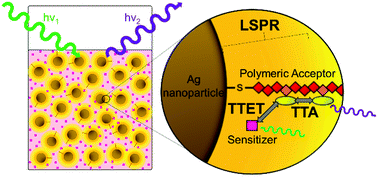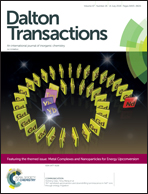Plasmon-enhanced triplet–triplet annihilation upconversion of post-modified polymeric acceptors†
Abstract
We report the localized surface plasmon resonance (LSPR)-enhanced triplet–triplet annihilation upconversion (TTA-UC) of polymeric acceptors containing high percentages of acceptor units. A poly[(methyl methacrylate)-co-(glycidyl methacrylate)] copolymer series with increasing glycidyl methacrylate ratio was prepared using reversible addition–fragmentation chain transfer (RAFT) polymerization. After post-modification of the glycidyl group with anthracene, the acceptor unit, a series of poly[(methyl methacrylate)-co-(2-hydroxypropyl-9-anthroate methacrylate)] (polyACA) was produced with different numbers of acceptor units. These polymeric acceptors were grafted to silver nanoparticles in order to enhance the TTA-UC intensity in the polymers with higher percentages of acceptor units, where concentration quenching usually dominates. With the assistance of the silver nanoparticle LSPR, TTA-UC intensity was enhanced from the polymeric acceptor nanocomposites using platinum octaethylporphyrin as the sensitizer to form the TTA-UC systems. This method is anticipated to improve TTA-UC in the solid-state, where higher percentages of acceptor units are required, but usually cause chromophore concentration quenching, reducing TTA-UC efficiency.

- This article is part of the themed collection: Metal Complexes and Nanoparticles for Energy Upconversion


 Please wait while we load your content...
Please wait while we load your content...